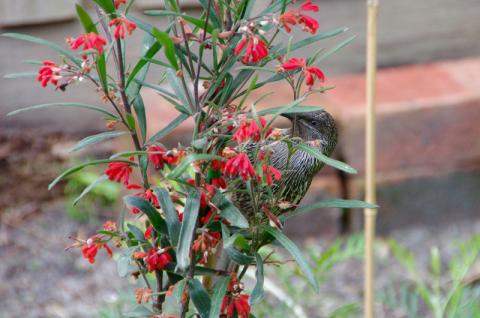
Little Wattlebirds are the first to wake and last to roost in our neighbourhood. Their unique range of calls are varied, loud and constant, with some of the stranger, harsh grating noises very unbirdlike. A Japanese visitor enquired about the strange noisy animals that woke him on his first morning in Australia. Upon being shown a Little Wattlebird in full voice he could not believe a bird, especially one that small, was responsible.
These vivacious Little Wattlebirds have become the common resident nectar feeders in our part of Sandringham. Competing directly with flocks of Noisy Miners for territory and food, Little Wattlebirds appear to be holding their own mainly because they appear to generally live within a contained area and strongly defend it. Red Wattlebirds were more common in our garden two decades ago however they are rarely sighted now. Smaller nectar eating honeyeaters such as the White naped, White plumed and Yellow faced are also rarely sighted. Possibly the territorial nature of our local Little Wattlebirds is directly affecting the presence of other nectar eaters.
One particular female has used our yard as her home base for many years, nesting elsewhere but always bringing her young ones into tall trees surrounding the house once they have fledged. During the day incessant squawking pinpoints, a moving location where both parents can bring their next feed. On early summer evenings she is joined by her partner and previous fledglings (they had four hatchings this spring and summer) and playtime begins as they swoop, dive, chase and pirouette, breaking from their games to catch flying insects.
There are many local birds I observe regularly with the Little Wattlebird by far the most energetic and playful and in our experience, also very communicative with humans. The female I mentioned above spends her nonbreeding months feeding from our Correas, Grevilleas and Banksias putting on acrobatic performances accompanied by various calls. Early mornings as I set out to take the dog walking, she sits in a Banksia by the front gate wishing us goodbye and welcoming us back 30 minutes later.
Watch out for Little Wattlebirds in your locality and you will be entertained, especially on a warm Summer evening. If you plant up nectar producing local indigenous plants in your gardens the more likely you will encourage nectar feeding Wattlebirds and Honeyeaters.
Denis Young



